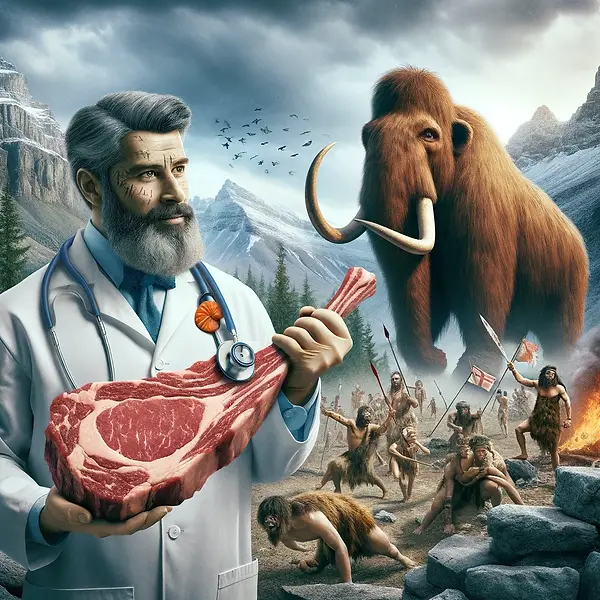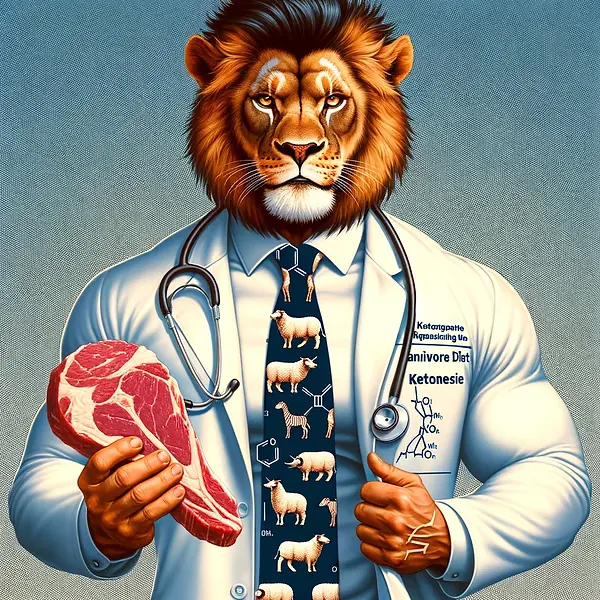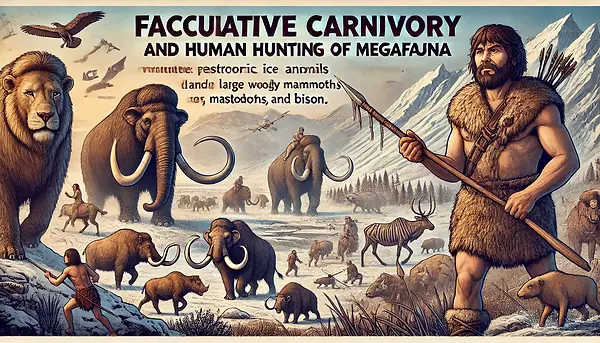
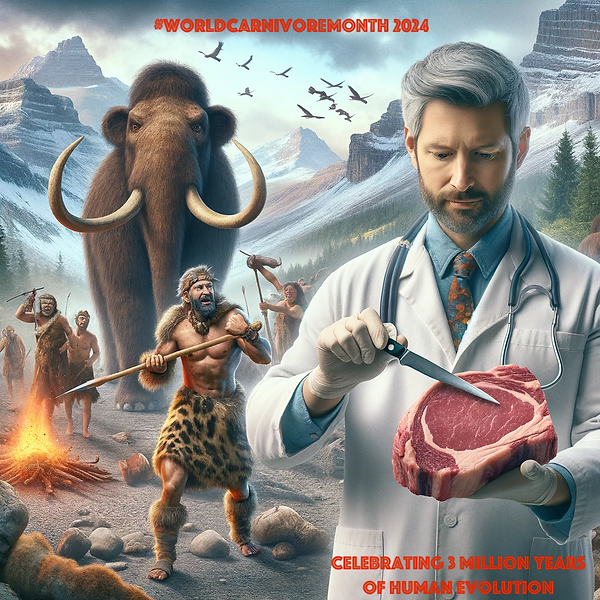
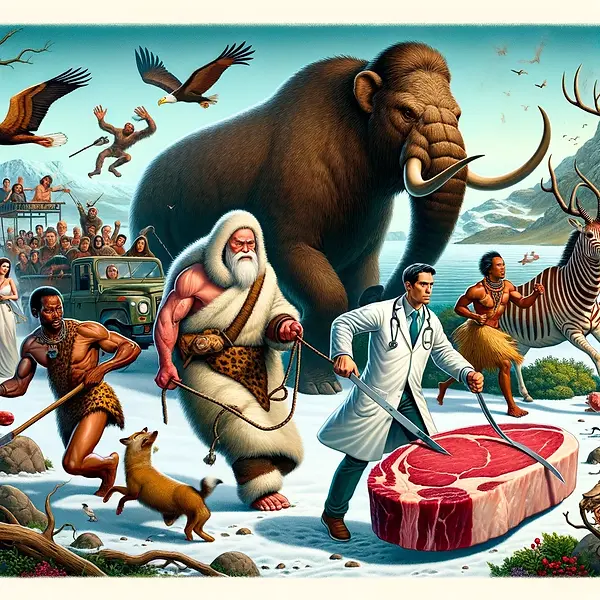
Title:
The evolution of the human trophic level during the Pleistocene - "Modern humans evolved from a low base to a high, carnivorous position during the Pleistocene."
Abstract:
The human trophic level (HTL) during the Pleistocene and its degree of variability serve, explicitly or tacitly, as the basis of many explanations for human evolution, behavior, and culture. Previous attempts to reconstruct the HTL have relied heavily on an analogy with recent hunter-gatherer groups' diets. In addition to technological differences, recent findings of substantial ecological differences between the Pleistocene and the Anthropocene cast doubt regarding that analogy's validity. Surprisingly little systematic evolution-guided evidence served to reconstruct HTL. Here, we reconstruct the HTL during the Pleistocene by reviewing evidence for the impact of the HTL on the biological, ecological, and behavioral systems derived from various existing studies. We adapt a paleobiological and paleoecological approach, including evidence from human physiology and genetics, archaeology, paleontology, and zoology, and identified 25 sources of evidence in total. The evidence shows that the trophic level of the Homo lineage that most probably led to modern humans evolved from a low base to a high, carnivorous position during the Pleistocene, beginning with Homo habilis and peaking in Homo erectus. A reversal of that trend appears in the Upper Paleolithic, strengthening in the Mesolithic/Epipaleolithic and Neolithic, and culminating with the advent of agriculture. We conclude that it is possible to reach a credible reconstruction of the HTL without relying on a simple analogy with recent hunter-gatherers' diets. The memory of an adaptation to a trophic level that is embedded in modern humans' biology in the form of genetics, metabolism, and morphology is a fruitful line of investigation of past HTLs, whose potential we have only started to explore.
Details
https://onlinelibrary.wiley.com/doi/10.1002/ajpa.24247
This is a must read overview of much of the evidence in this database.
In Figure 1, the evidence appears according to the Homo species and the inferred HTL with reference to their evidence type.Figure 2 demonstrates the evolution of the HTL during the Pleistocene as we interpret it, based on the totality of the evidence. Each line in the figure represents one mammalian species of the 137 species in the Pineda-Munoz and Alroy (2014) dataset, and they appear from left to right in descending relative plant consumption.The primates in Pineda-Munoz and Alroy (2014) dataset are specialized plant-eaters. There is little argument that meat was not the main food of early hominins (Ungar & Sponheimer, 2011), but it appears that at least 3.2 Mya, australopiths may have increased the portion of meat in their diet (McPherron et al., 2010). The appearance of the genus Homo was associated with a gradual increase of the animal component in the diet. Early Homo has initially expanded the diet from major reliance on plant foods to scavenging of bone marrow and brains and meat (S. C. Antón et al., 2014; Pante et al., 2018; Sayers & Lovejoy, 2014; J. Thompson et al., 2019; Ungar, 2012). Consistent signs of increased concentration on animal-sourced foods appear in H. erectus (Foley, 2001, and see Zooarchaeology section in this article).Most of the evidence that has been collected and analyzed in this article (Figure 1) points to a carnivore trophic level for humans during most of the Paleolithic, starting with H. erectus. In seven pieces of evidence (adipocyte morphology, stomach acidity, age at weaning, stable isotopes, paleontology, behavioral adaptations, Insulin resistance), the authors themselves allocate humans to the carnivore guild. A further six pieces of evidence point to humans' specialization in animals' exploitation, while an additional six pieces of evidence simply point to increased consumption of animals. However, eight pieces of evidence cannot safely be assigned to H. erectus as they are found in present humans, and it is not known if they also occurred in H. erectus. Safe evidence for some decline in trophic level start to appear toward the Middle Paleolithic (cooking) in the MP (AMY 1 multicopy), and a slight increase in plant-sourced food consumption in Africa some 85 Kya is suggested by a change in the FADS gene family, which enable the synthesis of omega 3 fats from vegetal sources (see Fat metabolism section herein). Evidence for a significant decline in trophic level appears mainly at the end of the Paleolithic with plants-dedicated stone tools, dental pathology, and analogies of 20th century HG technology and ecological conditions.Thus, we can present a hypothesis for the evolution of the HTL during the Paleolithic whereby consumption of animal-sourced food increased with early Homo and peaked in H. erectus. H. erectus was morphologically and behaviorally adapted to carnivory, was a social hunter of megafauna, possibly specializing in large prey, which, by zoological analogy, would have been a hypercarnivore with some 70% of the diet derived from animals. A certain decline in HTL may have occurred in H. sapiens in Africa, especially toward the end of the MP; however, it was not significant enough or long enough to change substantial carnivorous biological features that prevail until today. A significant decline in HTL occurred late in the Paleolithic, when technological changes allowed a significantly higher consumption of plants, possibly compensating for a marked decline in prey size and abundance and the consequent decline in fat availability to complete the non-protein portion of the diet.Taking a broader perspective, we note that, among mammals, there are fewer speciations within omnivory, but more speciations from omnivory to carnivory and from carnivory to omnivory (Price et al., 2012). Taken together with the general mammalian tendency toward specialization (Pineda-Munoz & Alroy, 2014), we suggest that the described “zig-zag” travel of Homo along the trophic spectrum from a lower trophic level to carnivory specialization and then back to the lower trophic level omnivory, was a natural mammalian evolutionary pathway.The evidence of an adaptation to a highly carnivorous trophic level for H. erectus and H. sapiens, and possibly a further specialization in the acquisition of large prey, present an alternative hypothesis to the one marking human adaptive transitions toward general resource variability (Potts et al., 2020). The selection for specialization in large prey instead of dietary variability, if accepted, can provide causality to the association made by Potts et al. (2018) between a decline in prey size in East Africa and the appearance of the MSA. Prey size decline drove cultural and physiological adaptation to acquire a larger portion of smaller prey in the hunting mix without sacrificing too much energy. A similar phenomenon of declining prey size followed by the cultural change was also identified in the Southern Levant continuously throughout the Paleolithic (Ben-Dor et al., 2011; Speth & Clark, 2006; M. C. Stiner et al., 2000) and in North America (Waters et al., 2020). A carnivorous trophic level can also support explanations of reliance on prey acquisition rather than adaptation to dietary variability as the enabling factor in H. erectus expansion to Eurasia 1.8 Mya and to humans' global dispersals in general.We found the ethnographic record to be a useful analogy not to a trophic level during all of the Pleistocene but rather to the terminal Pleistocene when cultural fragmentation and increased plant food consumption is evident. On a general note, the substantial ecological and technological, as well as the social changes that 20th-century HG went through, should caution us from the simplistic employment of analogies with the Pleistocene. As we noted, the best candidates for valid analogies are those that remain common in many groups of 20th-century HG, regardless of variability in their ecological, technological, and social circumstances. Sharing or, indeed, preference for fatter and larger prey are good examples of such candidates (Jerozolimski & Peres, 2003; Jochim, 1981; Kaplan et al., ).Regarding future research, specialization in carnivory and large prey calls for additional research of changes in the abundance of prey in general, and large prey in particular as a potential ecological driver of evolutionary and cultural changes during the Paleolithic. Further, the relative dearth of plant remains, and the inability to quantify plants and animals' consumption from the archaeological record is frustrating. However, quantitative measures may be applied to a set of archaeological assemblages to elucidate patterns of consumption. For example, quantification of dental plaque findings and their content, relative to previous periods, may point to trends in plant consumption. Similarly, although the absolute portion of animals' contribution to the diet cannot be learned from zooarchaeological assemblages, temporal trends in prey size can be quantified.A deeper study of phenotypic plasticity and technological and ecological influence on dietary plasticity can help understand humans' degree of dependence on one trophic group or another and the need for evolutionary and cultural change to meet changing ecological conditions. For example, the genetic change in the ability of H. sapiens to convert plant source omega-3 oils to DHA 85 Kya in Africa seems like an increase in dietary phenotypic plasticity, and it may be worthwhile to look for technological and ecological signs of increased dietary plasticity at the same time and place.There is no need to expand on the contribution of multidisciplinarity to the understanding of almost any subject. Future investigations, similar to this article, could benefit from the contribution of a wider group of experts than we have assembled. We are looking forward to specific criticism of our findings and interpretations and to additional evidence of the type that was presented in this article so that, as Wilkinson (2014) stated, we make progress in the first task of the prehistorian—study which trophic level humans occupied during the course of their evolution.
Hypothesis:
Humans evolved into facultative carnivores.

